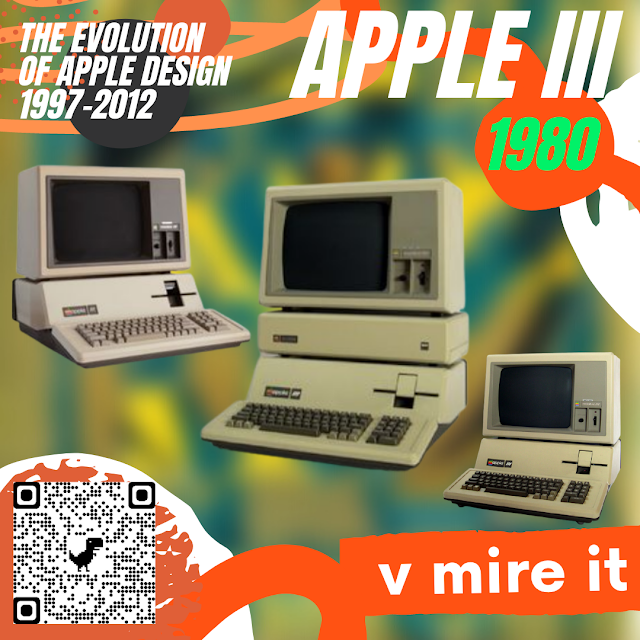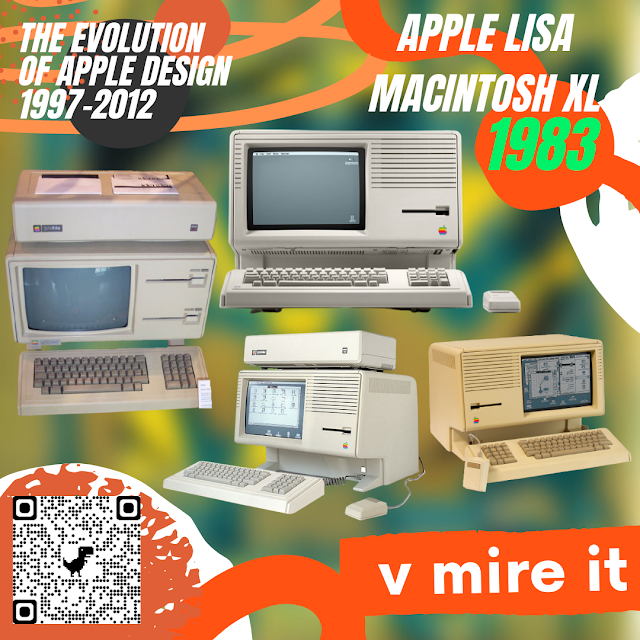Клавиатура Apple IIe отличалась тем, что была встроена в компьютер.
Apple IIe - третья модель в серии персональных компьютеров Apple II, производимых Apple Computer. Буква "e" в названии означает «расширенная версия», поскольку в модель были встроены несколько популярных функций, которые в более ранних моделях были доступны только в качестве обновлений или надстроек. Новые функции сделали машину очень привлекательной для тех, кто впервые покупал компьютер. Эта модель линейки компьютеров Apple II перед снятием с производства производилась и продавалась в течение почти 11 лет с относительно небольшими модификациями. В связи с этим IIe заслужила звание самого долгоиграющего компьютера в истории Apple.
Разработчик: Apple Computer
Тип: Настольный
Дата выхода: январь 1983 г.
Начальная цена: основной блок 1395 долларов США (эквивалент 3581 доллара США в 2019 году). За 1995 долларов США (5121 доллар США) в комплект были включены в основной блок с диском II и контроллером, Apple Monitor III с подставкой, а также расширенной текстовой картой на 80 столбцов.
Снято с производства: ноябрь 1993 г.
Операционная система: Apple DOS 3.3, ProDOS
CPU: MOS Technology / Synertek 6502 @ 1.023 MHz (Original // e); NCR / GTE 65C02 @ 1.023 МГц (Enhanced // e и Extended IIe)
Оперативная память: 64 КБ (до 1 МБ)
Предшественник: Apple II Plus
Эта новая модель Apple II - Apple IIe (условные наименования: «Диана» и «Super II») появилась после трех с половиной лет простоя. Apple IIe вышла в январе 1983 года и стала преемником Apple II Plus. В дизайне Apple IIe были позаимствованы некоторые аппаратные и программные особенности Apple III. Совокупность этих изменений привела к увеличению продаж и увеличению доли рынка для компании.
Самым важным дополнением была возможность ввода и отображения строчных букв. Другие улучшения клавиатуры включали четырехстороннее управление курсором и стандартные клавиши редактирования (Delete и Tab), две специальные клавиши-модификаторы Apple (Open и Solid Apple) и безопасное перемещение клавиши «Reset». Функция автоповтора (любая клавиша, удерживаемая для непрерывного повторения одного и того же символа) здесь работала автоматически и больше не требовала нажатия клавиши «REPT», как на клавиатуре предыдущей модели.
В стандартную комплектацию машины входило ОЗУ 64 КБ с эквивалентом встроенной языковой карты Apple Language Card, а также имелся новый специальный «вспомогательный слот» (заменяющий слот-0, хотя сопоставленный с слотом-3 для совместимости с более ранними версиями) для карт сторонних производителей на 80 столбцов) для добавления дополнительной памяти с помощью карт RAM с переключением банков.
Одним из наиболее заметных улучшений Apple IIe было добавление полного набора символов ASCII и клавиатуры.
The Apple IIe keyboard was built in to the computer and did away with the numeric keypad.
The Apple IIe is the third model in the Apple II series of personal computers produced by Apple Computer. The e in the name stands for enhanced, referring to the fact that several popular features were now built-in that were formerly only available as upgrades or add-ons in earlier models. Improved expandability combined with the new features made for a very attractive general-purpose machine to first-time computer shoppers. As the last surviving model of the Apple II computer line before discontinuation, and having been manufactured and sold for nearly 11 years with relatively few changes, the IIe earned the distinction of being the longest-lived computer in Apple's history.
Developer: Apple Computer
Type: Desktop
Release date: January 1983
Introductory price: Main unit US$1,395 (equivalent to $3,581 in 2019). US$1,995 ($5,121) included main unit with: Disk II and controller, Apple Monitor III and stand, and Extended 80-Column Text Card
Discontinued: November 1993
Operating system: Apple DOS 3.3, ProDOS
CPU: MOS Technology/Synertek 6502 @ 1.023 MHz (Original //e); NCR/GTE 65C02 @ 1.023 MHz (Enhanced //e and Extended IIe)
Memory: 64 KB of RAM (up to 1 MB)
Predecessor: Apple II Plus
After three and a half years at a stand-still, came the introduction of a new Apple II model—the Apple IIe (codenamed: “Diana” and “Super II”). The Apple IIe was released in January 1983, the successor to the Apple II Plus. Some of the hardware and software features of the Apple III were borrowed in the design of the Apple IIe. The culmination of these changes led to increased sales and greater market share of both home.
The most important addition is the ability to input and display lower-case letters. Other keyboard improvements include four-way directional cursor control and standard editing keys (Delete and Tab), two special Apple modifier keys (Open and Solid Apple), and a safe off-to-side relocation of the “Reset” key. The auto-repeat function (any key held down to repeat same character continuously) is now automatic, no longer requiring the “REPT” key (now gone) found on the previous model’s keyboard.
The machine came standard with 64 KB RAM, with the equivalent of a built-in Apple Language Card in its circuitry, and had a new special “Auxiliary slot” (replacing slot-0, though electronically mapped to slot-3 for compatibility with earlier third-party 80 column cards) for adding more memory via bank-switching RAM cards.
One of the most notable improvements of the Apple IIe is the addition of a full ASCII character set and keyboard.
LISA/MACINTOSH XL
Компьютер Lisa печально известен курьезом. Эта модель выиграла напряженную гонку среди компьютеров серии Macintosh, став первым настольным компьютером с интуитивно понятным графическим интерфейсом. Но компьютер не понравился публике. Этому способствовала цена машины в 10 000 долларов при полном отсутствии в комплекте программных продуктов.
Модель Macintosh XL является точной копией Lisa 2/10. Различаются только наклейка на коробке, операционная система и инструкция по эксплуатации. Вместо ОС Lisa в комплект поставки входит системное программное обеспечение Macintosh и MacWorks XL.
Изменение бейджа XL было попыткой Apple спасти плохо продававшуюся модель Lisa, которая вошла в линейку Macintosh. В результате Apple оказалась неподготовленной к рекордному количеству заказов на этого "новейшего" члена семейства Macintosh. Тем не менее, Macintosh не является прямым потомком Lisa, хотя между системами есть очевидное сходство, и последняя версия, Lisa 2/10, была модифицирована и продавалась как Macintosh XL.
Проект Lisa был начат в Apple в 1978 году и превратился в проект по разработке мощного персонального компьютера с графическим пользовательским интерфейсом (GUI), ориентированного на бизнес-клиентов.
Lisa была более продвинутой (и намного более дорогой) системой, чем Macintosh того времени, во многих отношениях, таких как
- наличие защищенной памяти,
- совместная многозадачность,
- в целом более сложная операционная система на основе жесткого диска,
- встроенная заставка,
- усовершенствованный калькулятор с бумажной лентой и RPN,
- поддержка до 2 мегабайт оперативной памяти,
- слоты расширения и большим дисплеем с более высоким разрешением.
Сложность операционной системы Lisa и ее программ требовала от микропроцессора Motorola 68000 все 5 МГц целиком, так что система заметно тормозила.
Оригинальная Lisa оснащена двумя 5-дюймовыми двусторонними дисководами Apple FileWare для гибких дисков, более известных под внутренним кодовым названием Apple как дисковод «Twiggy». Каждый из них имел емкость около 871 килобайт, но для этого требуются специальные дискеты. Накопители проявили себя как ненадежные, поэтому Macintosh, который изначально проектировался с одним Twiggy, в январе 1984 года был переконструирован для использования микрофлоппи-дисковода Sony 400k. Также предполагался дополнительный внешний 5 МБ или, позже, 10 МБ диск Apple и жесткий диск ProFile (разработанный для Apple III).
Также известна как Locally Integrated System Architecture (локально интегрированная системная архитектура)
Разработчик: Apple Computer
Производитель: Apple Computer
Тип: Персональный компьютер
Дата выхода: 19 января 1983 г.
Начальная цена: 9 995 долларов США (эквивалентно 25 811,18 долларов США в 2020 году). Производство прекращено: 1 августа 1986 г.
Продано единиц: 10 000
Операционная система: Lisa OS, Xenix
Процессор: Motorola 68000 @ 5 МГц
Предшественник: Apple II Plus, Apple III
Преемник: Macintosh XL, Macintosh
Технические характеристики Macintosh XL
Производитель: Apple Computer, Inc.
Дата выхода: 1 января 1985 г.
Начальная цена: 3995 долларов США (эквивалент 9 497 долларов США в 2019 году).
Снято с производства: 29 апреля 1985 г.
Операционная система: MacWorks XL / System 1.1,2.0, 2.1, 3.0, 3.2;
MacWorks Plus / System 1.1–6.0.3;
MacWorks Plus II / Система 1.1–6.0.8, 7.0–7.5.5
Процессор: Motorola 68000 @ 5 МГц
Память: 512 КБ ОЗУ (карта Lisa DRAM) с возможностью расширения до 2 МБ
Предшественник: Apple Lisa, Macintosh 512K
Преемник: Macintosh Plus
Хотя в документации, поставляемой с оригинальной Lisa, она упоминалась только как Lisa, официально Apple заявила, что это название является аббревиатурой от Local Integrated Software Architecture или «LISA». Поскольку первую дочь Стива Джобса (родившуюся в 1978 году) звали Лиза Джобс, обычно предполагают, что возможно, аббревиатура соответствовала ее имени. В ходе разработки компьютера Херцфельд и другие разработчики программного обеспечения использовали рабочее название «Lisa придуманная нами глупая аббревиатура», рекурсивный бэкроним. Также дочь другого члена команды разработчиков Lisa Ларри Теслера зовут Лиза.
While Lisa won the legendary race between itself and the Macintosh by being the first desktop computer to market with an intuitive GUI, it flopped with the public due to sticker shock at its $10,000 price tag and a lack of software titles.
The Macintosh XL is an exact replica of the Lisa 2/10. The only difference is the sticker on the box, the operating system and the instruction manual. Macintosh and MacWorks XL system software is included instead of Lisa OS.
The re-badging of the XL was a last-ditch effort by Apple to save the poorly-selling Lisa which had been usurped by the Macintosh line. After two years of marginal sales, Apple was unprepared for the record number of orders placed for the newest member of the Macintosh family.
The Lisa project was started at Apple in 1978 and evolved into a project to design a powerful personal computer with a graphical user interface (GUI) that would be targeted toward business customers.
However, the Macintosh is not a direct descendant of the Lisa, although there are obvious similarities between the systems, and the latest version, Lisa 2/10, has been modified and marketed as the Macintosh XL.
The Lisa was a more advanced (and far more expensive) system than the Macintosh of that time in many respects, such as its inclusion of protected memory, cooperative multitasking, a generally more sophisticated hard disk based operating system, a built-in screensaver, an advanced calculator with a paper tape and RPN, support for up to 2 megabytes of RAM, expansion slots, and a larger higher resolution display.
The complexity of the Lisa operating system and its programs taxed the 5 MHz Motorola 68000 microprocessor so that the system felt sluggish, particularly when scrolling in documents. The original Lisa has two Apple FileWare 5¼ inch double-sided floppy disk drives, more commonly known by Apple’s internal code name for the drive, “Twiggy”. They have a capacity of approximately 871 kilobytes each, but required special diskettes. The drives have the reputation of not being reliable, so the Macintosh, which was originally designed to have a single Twiggy, was revised to use a Sony 400k microfloppy drive in January 1984. An optional external 5 MB or, later, a 10 MB Apple ProFile hard drive (originally designed for the Apple III) was also offered.
Specifications Lisa
Also known as Locally Integrated System Architecture
Developer Apple Computer
Manufacturer Apple Computer
Type Personal computer
Release date January 19, 1983; 38 years ago
Introductory price US$9,995 (equivalent to $25,811.18 in 2020)
Discontinued August 1, 1986
Units sold 10,000
Operating system Lisa OS, Xenix
CPU Motorola 68000 @ 5 MHz
Predecessor Apple II Plus, Apple III
Successor Macintosh XL, Macintosh
Specifications Macintosh XL
Manufacturer: Apple Computer, Inc.
Release date: January 1, 1985
Introductory price: US$3,995 (equivalent to $9,497 in 2019)
Discontinued: April 29, 1985
Operating system: MacWorks XL / System 1.1,2.0, 2.1, 3.0, 3.2;
MacWorks Plus / System 1.1–6.0.3;
MacWorks Plus II / System 1.1–6.0.8, 7.0–7.5.5
CPU: Motorola 68000 @ 5 MHz
Memory: 512 KB RAM (the Lisa DRAM card), expandable to 2 MB
Predecessor: Apple Lisa, Macintosh 512K
Successor: Macintosh Plus
While the documentation shipped with the original Lisa only ever referred to it as The Lisa, officially, Apple stated that the name was an acronym for Local Integrated Software Architecture or “LISA”. Since Steve Jobs’ first daughter (born in 1978) was named Lisa Jobs, it is normally inferred that the name also had a personal association, and perhaps that the acronym was invented later to fit the name. Hertzfeld states that the acronym was reverse engineered from the name “Lisa” in autumn 1982 by the Apple marketing team, after they had hired a marketing consultancy firm to come up with names to replace “Lisa” and “Macintosh” (at the time considered by Rod Holt to be merely internal project codenames) and then rejected all of the suggestions. Privately, Hertzfeld and the other software developers used “Lisa: Invented Stupid Acronym”, a recursive backronym. It is also important to note that Lisa team member Larry Tesler’s daughter is named Lisa.
APPLE IIC
Apple IIc, четвертая модель в серии персональных компьютеров Apple II. Первая попытка Apple Computer создать портативный компьютер. Результатом стала версия Apple II размером с ноутбук - портативная альтернатива и дополнение к Apple IIe. Буква c в названии означает «компактный». Внутреннее название Apple IIc было «Lolly». По сути это был полноценный компьютер Apple II, в компактном корпусе. Компьютер оснащен встроенным флоппи-дисководом и новыми портами расширения на задней панели, интегрированными в основную логическую плату. Но в нем отсутствуют внутренние слоты расширения и прямой доступ к материнской плате, как у более ранних моделей Apple II, что делает его закрытой системой, подобно Macintosh.
 |
| The Apple IIc |
Это была первая из трех моделей Apple II в стиле «Белоснежка», и единственная, в которой использовался эксклюзивный белый кремовый цвет. (Другие компьютеры Snow White в серии Apple II, II GS и IIc Plus, были светло-серыми, Apple называла их «Platinum».) Также IIc не был укомплектован устаревшей крышкой отсека для кассет.
Apple IIc был первым компьютером в серии Apple II, использующим 65C02. вариант процессора 6502 с низким энергопотреблением. в нем был встроенный 5,25-дюймовый дисковод для гибких дисков и 128 КБ ОЗУ, со встроенным контроллером диска, который мог управлять внешними дисками, передачей композитного видеосигнала (NTSC или PAL). Машина была оснащена интерфейсами модема, принтером и портом, который можно использовать для джойстика или мыши. Apple IIc не имел внутренних слотов расширения, благодаря чему и был достигнут его компактный размер. Владельцы компьютера использовали на нем до 1 МБ дополнительной памяти. Компьютер был оснащен часами реального времени, а более поздняя версия материнской платы включала слот расширения, который мог принять карту памяти Apple с объемом до 1 МБ.
Машины IIc поддерживали 16-цветной двойной графический режим с высоким разрешением и, с точки зрения программного обеспечения, были идентичны таковым на IIe.
Модель Apple IIc позволяла отображать изображения в 80 столбцов, цветную графику и была оснащена 9-дюймовым дисплеем с зеленым люминофором. Монитор был снабжен специальной подставкой, которая приподнимала его над поверхностью, позволяя разместить компьютер под ним. В Apple IIc были представлены 32 новых графических символа под названием MouseText и ПЗУ с новой версией dell'Applesoft BASIC.
 |
| The Apple IIc |
Apple также выпустила два ЖК- монитора, но плохая резкость и высокая стоимость не сделали их популярными. Сторонние производители выпускали ЖК-мониторы более высокого качества, которые пользовались большей популярностью. IIc имел внешний источник питания, который преобразовывал мощность переменного тока в 12 В постоянного тока, что позволяло третьим сторонам предлагать аккумуляторы и подключенные автомобильные адаптеры питания вместо прилагаемого адаптера переменного тока.
Apple IIc (в его американской версии) был первым микрокомпьютером, который поддерживал упрощенную клавиатуру Дворжака, которая активировалась с помощью переключателя над клавиатурой. Эта функция также была обнаружена и на американских компьютерах Apple IIe (хотя ключ находился внутри компьютера) и на Apple II GS (доступна через внутреннюю панель управления). Экспортные модели использовали тот же механизм для переключения между локализованной и американской раскладками клавиатуры, но не предлагали клавиатуру Дворжака.
Тем не менее, концепция модели - бытовой прибор, готовый к работе сразу после распаковки, не требующий технических ноу-хау или опыта для подключения и, следовательно, привлекательная для начинающих пользователей, сыграла положительную роль. Модель «IIc» даже снабжалась ручкой для переноски, которая убиралась под корпус, позволяя установить компьютер в удобное для печати положение. При этом, несмотря на то, что компьютер продавался как портативный, для его использования требовался отдельный монитор и источник питания.
Apple IIc, как наиболее впечатляющее на тот момент достижение в области электроники, экспонировался и даже появился на обложке каталога выставке «Информационные технологии в жизни США», проходившей в 1987-1988 годах в СССР. Эта выставка демонстрировала успехи США в области вычислительной техники. Об её уровне можно судить по тому, что каталог открывался обращением президента США Рональда Рейгана к её посетителям.
Apple II широко клонировался как в Соединенных Штатах, так и за рубежом.
Например, Apple судилась VTech, которая в 1984 году выпустила компьютер Laser 128, улучшенный клон Apple IIC. Судебная тяжба не увенчалась успехом, поскольку VTech реконструировал ПЗУ машины, а не скопировал. Кроме того, VTech лицензировал ПО Applesoft у Microsoft. Это стало возможным, потому что Apple не требовала у Microsoft исключительных прав на BASIC Applesoft. Компьютер Laser 128 стал популярен, и позднее вышла улучшенная версия, работающей быстрее 1 МГц. Машина не была полностью совместим с Apple II, он была настолько популярна, что большинство разработчиков позаботились о том, чтобы их программное обеспечение могло работать на Laser.
Разработчик: Apple Computer, Inc.
Дата выхода: 24 апреля 1984 г.; 37 лет назад
Начальная цена: 1295 долларов США (эквивалент 3190 долларов США в 2019 году).
Снято с производства: август 1988 г.
Операционная система: ProDOS
Процессор: 65C02 @ 1.023 МГц, MOS Technology 65C02, 8 бит, 1.024 МГц
Память: 128 КБ ОЗУ (до 1,125 МБ)
Системная шина: 1,4 МГц
ОЗУ: 128 КБ , с возможностью расширения до 1 МБ
ROM: 32 кб
Дисплей: 24 × 80 знаков. 4-битный цвет в 40x48, 3-битный цвет в 280x192, 1-битный цвет в 560x192
Экран: 9 дюймов, монохромный, зеленый или оранжевый
Звук: внутренний динамик
Дисковод гибких дисков: 5 ¼ "143 КБ, внутренний
Слоты расширения: нет слота расширения, но есть несколько проприетарных портов (последовательный, дисковый, мышь и т. д.)
Порты: разъем Scart, 2 последовательных порта, порт для внешнего накопителя, разъем для мыши, контроллера или джойстика.
***
ENG
***
The Apple IIc, the fourth model in the Apple II series of personal computers, is Apple Computer's first endeavor to produce a portable computer. The result was a 7.5 lb notebook-sized version of the Apple II that could be transported from place to place - a portable alternative and complement to the Apple IIe. The Apple IIc was codenamed "Lolly" in some internal documents prior to its release. The c in the name stood for compact, referring to the fact it was essentially a complete Apple II computer setup squeezed into a small notebook-sized housing. While sporting a built-in floppy drive and new rear peripheral expansion ports integrated onto the main logic board, it lacks the internal expansion slots and direct motherboard access of earlier Apple II models, making it a closed system like the Macintosh.
It was the first of three Snow White Apple II models, and the only one to feature the exclusive white cream color. (Other Snow White computers in the Apple II, II GS, and IIc Plus series were light gray; Apple called them “Platinum.”) Also, the IIc did not come with the outdated cassette cover.
The Apple IIc was the first computer in the Apple II series to use 65C02. a low power variant of the 6502 processor. it had a built-in 5.25-inch floppy drive and 128KB of RAM, with a built-in disk controller that could drive external drives, composite video (NTSC or PAL). The machine was equipped with modem interfaces, a printer, and a port that could be used for a joystick or mouse. The Apple IIc did not have internal expansion slots, which resulted in its compact size. Owners of the computer used up to 1 MB of additional memory on it. The computer was equipped with a real-time clock, and the later version of the motherboard included an expansion slot that could accept an Apple memory stick up to 1MB.
The IIc machines supported a high-resolution 16-color dual graphics mode and, in terms of software, were identical to those on the IIe.
The computer came with two different monochrome LCD monitors. Both were short-lived due to their high cost and poor readability. The IIc had an external power supply that converted AC power to 12V DC, allowing third parties to offer batteries and connected car power adapters in place of the supplied AC adapter.
 |
| The Apple IIc |
The Apple IIc (in its American version) was the first microcomputer to support the simplified Dvorak keyboard, which was activated with a switch above the keyboard. This feature was also found on American Apple IIe computers (although the key was inside the computer) and on the Apple II GS (accessible through the internal control panel). Export models used the same mechanism to switch between localized and US keyboard layouts, but did not offer the Dvořák keyboard.
However, that was the intended direction for this model — a more appliance-like machine, ready to use out of the box, requiring no technical know-how or experience to hook up and therefore attractive to first-time users. The IIc even had a carrying handle that tucked away underneath the case, allowing the computer to be positioned in a comfortable typing position. That said, although the computer was marketed as a portable computer, it required a separate monitor and power supply to use it. The Apple IIc, as the most impressive achievement in the field of electronics at that time, was exhibited and even appeared on the cover of the catalog at the Information Technology in the Life of the United States exhibition held in 1987-1988 in the USSR. This exhibition showcased US advances in computing. Its level can be judged by the fact that the catalog was opened with an address by US President Ronald Reagan to its visitors.
The Apple II has been widely cloned both in the United States and abroad.
For example, Apple sued VTech, which in 1984 released the Laser 128, an improved Apple IIC clone. The litigation was unsuccessful as VTech remodeled the car rather than copied it. In addition, VTech has licensed Applesoft software from Microsoft. This was possible because Apple did not claim Microsoft's exclusive rights to BASIC Applesoft. The Laser 128 computer became popular, and later an improved version was released, running faster than 1 MHz. The machine was not fully compatible with the Apple II, it was so popular that most of the developers made sure their software could run on the Laser.
Developer: Apple Computer, Inc.
Release date: April 24, 1984
Introductory price: US$1,295 (equivalent to $3,190 in 2019)
Discontinued: August 1988
Operating system: ProDOS
CPU: 65C02 @ 1.023 MHz
Memory: 128 kB of RAM (up to 1.125 MB)
System bus: 1.4 MHz
RAM: 128KB, expandable up to 1MB
ROM: 32 kb
Display: 24 × 80 characters. 4-bit color at 40x48, 3-bit color at 280x192, 1-bit color at 560x192
Screen: 9-inch, monochrome, green or orange
Sound: internal speaker
Floppy disk drive: 5 ¼ "143 KB internal
Expansion slots: no expansion slot, but there are a few proprietary ports (serial, disk, mouse, etc.)
Ports: Scart connector, 2 serial ports, external storage port, mouse, controller or joystick connector.
Аппаратное обеспечение Apple * Apple hardware
































Комментарии
Отправить комментарий